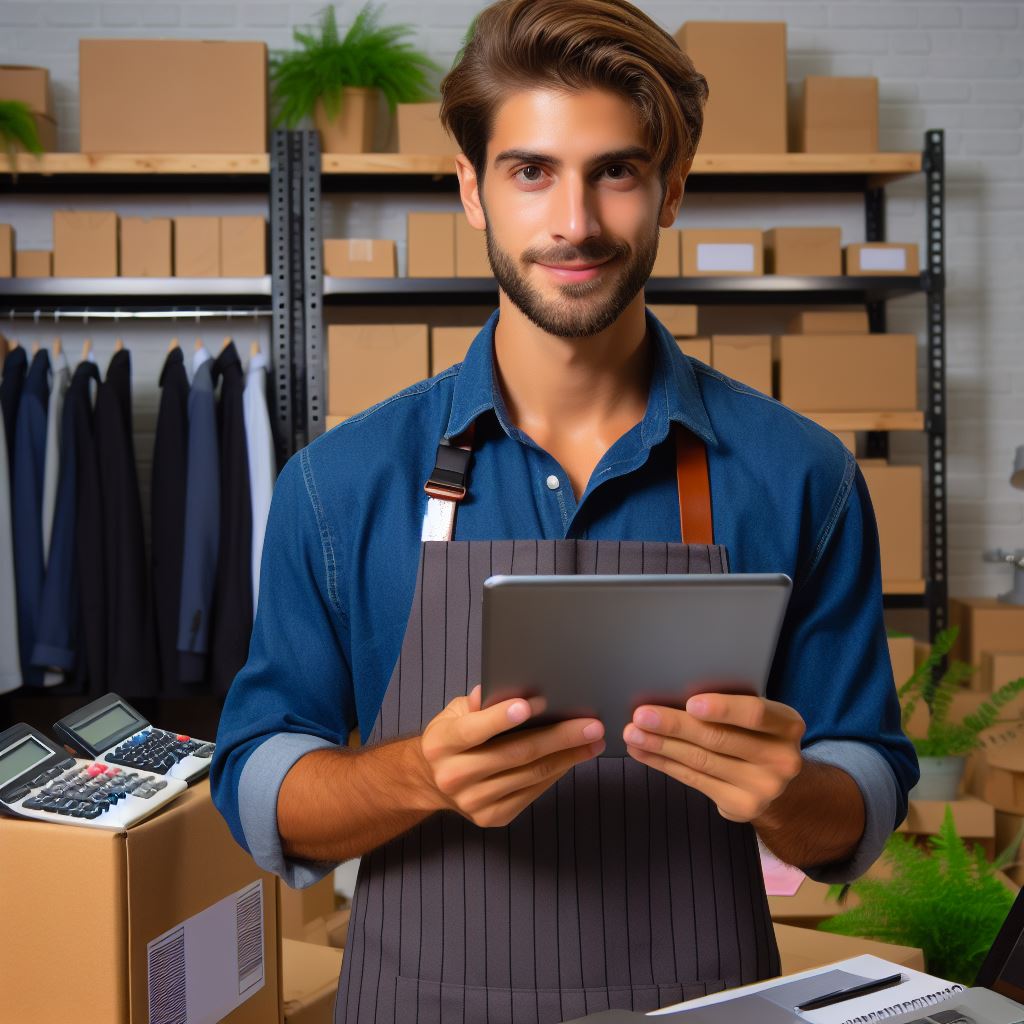Introduction
In the world of sales, merchandising plays a crucial role in driving success. It encompasses various strategies and techniques used to promote and sell products effectively.
By creating visually appealing displays, optimizing product placement, and utilizing promotional materials, merchandising helps to attract, engage, and convert customers.
The future of merchandising is constantly evolving, thanks to advancements in technology and changing consumer behaviors. As the retail landscape continues to shift, businesses must adapt their merchandising strategies to stay ahead of the competition.
One key aspect of the future of merchandising is the growing importance of online sales. With the rise of e-commerce, businesses have a much larger audience to reach, but also face greater competition for attention.
Effective online merchandising involves optimizing product listings, providing detailed descriptions and high-quality images, and utilizing data-driven insights to personalize the shopping experience.
Another trend shaping the future of merchandising is the integration of technology and data analytics.
Retailers can leverage technologies such as augmented reality, virtual reality, and artificial intelligence to enhance the in-store and online shopping experience.
By using data analytics, businesses can gain valuable insights into customer preferences and behaviors, enabling them to tailor their merchandising strategies accordingly.
Furthermore, sustainability is becoming an increasingly important factor in merchandising.
Consumers are increasingly conscious of the environmental impact of their purchasing decisions, and businesses that prioritize sustainable practices can gain a competitive edge.
Incorporating eco-friendly materials, minimizing packaging waste, and promoting ethical sourcing are some ways in which merchandising can align with sustainability.
In essence, the future of merchandising in sales is an exciting and dynamic field. Businesses must embrace new technologies, leverage data analytics, and prioritize sustainability to thrive in an evolving marketplace.
By staying ahead of trends and continuously innovating, companies can optimize their merchandising strategies and drive sales growth.
Current state of merchandising in sales
In the current state of merchandising in sales, physical stores still have a significant impact.
Visual merchandising plays a crucial role in attracting and enticing customers to make purchases.
However, traditional merchandising faces numerous challenges in today’s competitive market.
- Physical stores offer a tangible experience that online shopping cannot replicate.
- The ability to touch, feel, and try products is a key selling point for customers.
- Stores provide a sense of instant gratification, allowing customers to take their purchases home immediately.
- Furthermore, physical stores allow for personal interaction between customers and sales associates.
- These interactions can positively influence buying decisions and foster customer loyalty.
Visual merchandising is also a powerful tool in driving sales within physical stores.
- Well-planned and executed visual displays can catch customers’ attention and encourage impulse buying.
- The strategic placement of products and attractive displays can create a sense of desire and urgency.
- Eye-catching window displays can entice potential customers to enter the store.
- Once inside, carefully arranged displays can guide customers through different product offerings.
- The use of colors, lighting, and props can enhance the overall shopping experience and increase sales.
However, traditional merchandising also faces several challenges in today’s sales landscape.
- Competition from online retailers has significantly impacted brick-and-mortar stores.
- Many customers now conduct product research online before making a purchase in-store.
- Online shopping offers convenience, competitive prices, and a wider product selection.
- Traditional stores must find innovative ways to attract customers and provide unique experiences.
- Additionally, traditional merchandising requires significant physical space to display products.
- This can be limiting for retailers, especially in high-rent locations.
- Furthermore, physical stores need to carefully manage inventory to avoid stockouts or overstocking.
- Effective inventory management is crucial to meet customer demands and maximize sales.
- Lastly, traditional merchandising relies heavily on human labor and expertise.
- Training and retaining knowledgeable sales associates is essential for delivering exceptional customer service.
In review, the current state of merchandising in sales is still heavily influenced by physical stores.
Visual merchandising plays a vital role in driving sales and creating memorable shopping experiences.
However, traditional merchandising faces various challenges due to increased competition from online retailers.
To thrive in this changing landscape, retailers must find innovative ways to attract customers and provide exceptional service.
Whether through eye-catching displays or personalized interactions, the future of merchandising lies in creating unique and engaging experiences for customers.
Technological advancements shaping the future of merchandising
The future of merchandising in sales is heavily influenced by technological advancements. These innovations are changing the way businesses operate and creating new opportunities for growth.
In this section, we will explore three key technological advancements that are shaping the future of merchandising: the rise of e-commerce, the role of data analytics, and the integration of artificial intelligence and machine learning in sales.
Your Personalized Career Strategy
Unlock your potential with tailored career consulting. Get clear, actionable steps designed for your success. Start now!
Get StartedRise of e-commerce
E-commerce has revolutionized the way consumers shop. With the advent of online marketplaces and mobile applications, customers can now purchase products and services with the click of a button.
This shift has had a profound impact on traditional retail, forcing businesses to adapt to the digital landscape or risk being left behind.
Role of data analytics in merchandising
Data analytics plays a crucial role in effective merchandising. By collecting and analyzing customer data, businesses can gain valuable insights into consumer behavior, preferences, and trends.
This information can then be used to tailor marketing strategies, optimize pricing, and identify new sales opportunities. Data analytics empowers businesses to make data-driven decisions and improve their overall merchandising efforts.
Artificial intelligence and machine learning in sales
Artificial intelligence (AI) and machine learning technologies are rapidly transforming the sales industry.
These technologies can process vast amounts of data and make accurate predictions, enabling businesses to personalize customer experiences and provide tailored product recommendations.
AI-powered chatbots and virtual assistants are becoming increasingly common, providing customers with immediate support and enhancing the overall shopping experience.
In addition to these key advancements, there are other notable technological trends shaping the future of merchandising. These include
- Augmented reality (AR) and virtual reality (VR) are revolutionizing the way customers experience products. AR and VR technologies allow customers to visualize how a product will look or function before making a purchase, bridging the gap between online and physical shopping
- Internet of Things (IoT) devices are creating opportunities for personalized merchandising. IoT-enabled devices can collect data on customer usage and preferences, enabling businesses to deliver targeted promotions and offers
- Mobile commerce is on the rise, with more and more consumers using their smartphones to make purchases. Businesses need to optimize their online platforms for mobile devices to capitalize on this trend
- Social media platforms have become powerful marketing tools. Businesses can leverage social media to connect with customers, showcase products, and drive sales.
Basically, technological advancements are revolutionizing the future of merchandising in sales.
The rise of e-commerce, the role of data analytics, and the integration of artificial intelligence and machine learning are just a few examples of how technology is transforming the industry.
To thrive in this rapidly evolving landscape, businesses must adapt and embrace these advancements to stay competitive and provide a seamless shopping experience for their customers.
Personalization and customization in merchandising:
Tailoring experiences to individuals
- In today’s competitive market, companies are realizing the importance of tailoring merchandising experiences to individual customers.
- By analyzing customer data, businesses can understand preferences and offer personalized product recommendations.
- Personalized experiences create a sense of uniqueness, making customers feel valued and more likely to make a purchase.
Benefits of personalized merchandising
- Increased customer satisfaction: Personalized recommendations enhance the shopping experience, saving customers time and effort.
- Improved conversion rates: When customers receive relevant recommendations, they are more likely to convert.
- Enhanced customer loyalty: Personalization builds stronger connections with customers, increasing their loyalty to the brand.
- Higher average order values and increased sales revenue: Personalized merchandising can lead to cross-selling and upselling opportunities.
- Data-driven insights: By analyzing customer preferences, businesses can gain valuable insights for effective merchandising strategies.
Examples of successful personalized merchandising
- Amazon’s personalized product recommendations have significantly contributed to their success. They suggest items based on browsing history, purchase patterns, and customer reviews.
- Netflix extensively uses personalization to recommend movies and TV shows based on a user’s viewing history, ratings, and genre preferences.
- Nike allows customers to design their own sneakers by selecting colors, materials, and styles, providing a personalized product experience.
- Coca-Cola’s “Share a Coke” campaign personalized their bottles and cans with common names, creating a sense of inclusion and personal connection.
- Spotify curates personalized playlists for users based on their music preferences, listening history, and algorithms.
Implementing personalization in merchandising
- Collecting customer data: Businesses can gather data from various sources, such as website analytics, purchase history, and customer surveys.
- Segmentation: Group customers based on common characteristics and buying behaviors to tailor recommendations effectively.
- Behavioral tracking: Tracking user behavior on websites allows businesses to understand individual preferences and offer relevant recommendations.
- AI and machine learning: Utilizing artificial intelligence and machine learning algorithms can analyze vast amounts of data and generate accurate recommendations.
- Testing and optimization: Continuously testing different merchandising strategies and analyzing their impact helps refine personalization efforts.
Challenges and considerations in personalized merchandising
- Privacy concerns: Personalization requires collecting and analyzing customer data, which requires adequate security measures and respect for privacy rights.
- Data accuracy and reliability: It is crucial to ensure the accuracy and reliability of customer data to provide meaningful and relevant recommendations.
- Balancing customization and overwhelming customers: Finding the right balance between personalization and overwhelming customers with options can be challenging.
- Constantly evolving technology: As technology advances, businesses must adapt to new tools and techniques to stay ahead in personalized merchandising.
To sum it up, personalization and customization play a vital role in the future of merchandising. Tailoring experiences to individuals not only enhances customer satisfaction but also boosts conversion rates and increases customer loyalty.
Successful examples from companies like Amazon, Netflix, Nike, Coca-Cola, and Spotify demonstrate the power of personalized merchandising.
By leveraging customer data, implementing AI and machine learning, and continuously testing and optimizing strategies, businesses can unlock the benefits of personalization while addressing challenges and considerations.
Read: Essential Skills for Aussie Retail Service Agents
Integration of online and offline merchandising strategies
The integration of online and offline merchandising strategies is crucial for the future of sales. Creating a seamless customer journey is a vital aspect of this integration.
Customers should be able to switch between online and offline channels effortlessly, without any disruption.
Utilizing digital tools in physical stores
Utilizing digital tools in physical stores can enhance the merchandising experience. Retailers can employ technologies like interactive displays, mobile apps, and virtual reality to engage and assist customers.
These tools can provide product information, offer personalized recommendations, and enable convenient purchasing options.
Building a consistent brand image across channels
One significant benefit of integrating online and offline merchandising strategies is the ability to build a consistent brand image across channels.
Both online and offline experiences should reflect the same brand values, offering a cohesive and recognizable identity to customers. Consistency helps in reinforcing brand loyalty and trust.
To achieve a seamless customer journey, retailers must invest in robust omni-channel strategies.
This involves integrating all sales and marketing channels, such as websites, social media platforms, physical stores, and mobile apps. It also requires providing a consistent customer experience across these channels.
“Enhancing Retail Experiences: The Power of Personalization and Omni-Channel Integration”
A key aspect of omni-channel merchandising is personalization. Retailers can leverage customer data to offer tailored product recommendations and promotions.
By analyzing customer preferences and purchase history, retailers can deliver a personalized shopping experience through targeted marketing efforts.
Another strategy is combining the convenience of online shopping with the tactile experience of physical stores. The rise of click-and-collect services offers customers the option to buy online and pick up their purchases in-store.
This not only saves time but also allows customers to experience the product firsthand before making a final decision.
Elevating Offline Retail: The Impact of In-Store Technologies on Customer Experience and Business Success
In-store technologies like augmented reality and interactive displays can enhance the offline shopping experience. Customers can virtually try on clothes or visualize how furniture would look in their homes.
These tools empower customers to make informed decisions and reduce the need for excessive returns.
Moreover, digital tools can provide valuable insights into customer behavior and preferences. Retailers can track online and offline interactions to understand customer preferences and improve merchandising strategies.
This data-driven approach enables retailers to react quickly to market trends and customer demands, ultimately increasing sales and customer satisfaction.
Stand Out with a Resume That Gets Results
Your career is worth more than a generic template. Let us craft a resume and cover letter that showcase your unique strengths and help you secure that dream job.
Get HiredPrioritizing Staff Training for Seamless Omni-Channel Integration
To successfully integrate online and offline merchandising strategies, retailers should prioritize staff training.
Sales associates should be knowledgeable about online channels, enabling them to assist customers in navigating online platforms, placing orders, and addressing any concerns.
This ensures a consistent customer experience regardless of the channel.
Overall, the integration of online and offline merchandising strategies is vital for the future of sales. Retailers must focus on creating a seamless customer journey, utilizing digital tools in physical stores, and building a consistent brand image.
By implementing omni-channel strategies and personalization, retailers can enhance the customer experience and drive sales.
Read: Aussie Service Agents: Adapting to Tech Changes

Learn More: Store Manager’s Guide to AU Market Trends
Virtual reality and augmented reality in merchandising
Virtual reality (VR) and augmented reality (AR) technologies have revolutionized the way businesses approach merchandising.
By creating immersive and interactive experiences for customers, these technologies enhance the shopping experience and drive sales.
Enhancing the shopping experience through immersive technologies
VR and AR technologies allow customers to engage with products and services in an entirely new way, blurring the line between the digital and physical worlds.
Through VR headsets or AR applications on their smartphones, customers can explore virtual stores, try on virtual clothes, or even visualize furniture in their own homes.
These immersive experiences provide customers with a deeper understanding of products and create a strong emotional connection.
By being able to interact with products virtually, customers can make more informed decisions and feel more confident in their purchases.
Potential applications of VR and AR in sales
The potential applications of VR and AR in sales are vast. Here are some ways in which businesses can leverage these technologies:
- Virtual product demonstrations: Instead of traditional product demonstrations, businesses can use VR to showcase the features and functionalities of their products in a virtual environment. This allows customers to get a hands-on experience without physically interacting with the product.
- Virtual shopping experiences: With VR, businesses can create virtual stores that replicate their physical locations or design entirely new immersive environments. Customers can browse through products, view detailed descriptions, and make purchases without leaving their homes.
- AR-powered try-on experiences: AR applications can enable customers to virtually try on clothes, accessories, or makeup. By overlaying virtual elements on their real-time image, customers can see how a product looks on them without physically trying it on.
- AR product visualization: Businesses can use AR to allow customers to visualize how products will look in their own space. Whether it’s furniture, home decor, or even cars, customers can use AR to see how the product fits and looks in their specific environment.
Examples of successful VR and AR merchandising campaigns
Several businesses have already implemented VR and AR merchandising campaigns with great success:
- Lowe’s Holoroom: Lowe’s, a home improvement retailer, created virtual reality showrooms where customers can explore different kitchen designs. This allowed customers to visualize renovation possibilities and make informed decisions.
- Sephora Virtual Artist: Sephora, a beauty retailer, developed an AR app that allows customers to try on makeup virtually. Customers can see how different shades and products look on their own face without physically applying them.
- IKEA Place: IKEA, a furniture retailer, introduced an AR app that enables customers to place virtual furniture in their homes. This helps customers visualize how the furniture will fit and look in their space before making a purchase.
These examples demonstrate how VR and AR can transform the shopping experience and drive sales by providing unique and engaging interactions with products.
In summary, the future of merchandising in sales lies in the integration of virtual reality and augmented reality technologies.
By leveraging these immersive technologies, businesses can enhance the shopping experience, provide customers with a deeper understanding of products, and drive sales.
The potential applications of VR and AR in sales are vast, ranging from virtual product demonstrations to AR-powered try-on experiences.
Successful campaigns by companies like Lowe’s, Sephora, and IKEA demonstrate the power of VR and AR in merchandising.
As these technologies continue to evolve, the possibilities for creating compelling and interactive shopping experiences are only bound to grow.
Read: Customer Loyalty: An Aussie Agent’s Guide
Discover More: Tech Tools Every Sales Rep Should Know
The role of sustainability in future merchandising
The future of merchandising in sales is closely linked to sustainability. As consumers become more conscious about the environment, the demand for eco-friendly products continues to increase.
Transform Your LinkedIn for Maximum Impact
Elevate your professional brand with a LinkedIn profile that attracts recruiters, showcases your expertise, and maximizes opportunities. Stand out in your industry with a profile built for success.
Boost ProfileIncreasing consumer demand for eco-friendly products
Consumers are becoming more aware of the impact their purchasing decisions have on the environment. They are actively seeking products that are produced using sustainable practices and materials.
As a result, businesses need to adapt their merchandising strategies to offer more eco-friendly options to meet the growing demand. This can involve sourcing sustainable materials, minimizing waste, and reducing carbon footprints.
Incorporating sustainability into merchandising strategies
Merchandising strategies need to evolve to incorporate sustainability as a core principle. This can be achieved by prioritizing eco-friendly products and emphasizing their advantages to consumers.
One way to do this is by prominently displaying environmental certifications or labels on products. This allows consumers to quickly identify sustainable options and make informed purchasing decisions.
In addition, businesses should consider how their products are packaged. Using recyclable materials or minimizing packaging waste can significantly contribute to sustainable merchandising practices.
Impact of sustainable practices on sales
Implementing sustainable practices in merchandising can have a positive impact on sales. Research has shown that consumers are willing to pay more for products with environmentally-friendly attributes.
By actively promoting sustainability, businesses are likely to attract a larger customer base and build customer loyalty. Consumers appreciate brands that align with their values and are more likely to become repeat customers.
Furthermore, businesses that adopt sustainable practices can benefit from positive word-of-mouth marketing.
Customers who are satisfied with their eco-friendly purchases are likely to share their experiences with friends and family, expanding the brand’s reach.
Sustainability plays a crucial role in the future of merchandising in sales. Businesses need to recognize the increasing consumer demand for eco-friendly products and adapt their strategies accordingly.
By incorporating sustainability into merchandising strategies and prioritizing environmentally-friendly options, businesses can attract a larger customer base, enhance customer loyalty, and ultimately increase sales.
It is clear that sustainability is no longer just a trend, but a fundamental aspect of successful merchandising in the future. Embracing sustainability will not only benefit the environment but also contribute to business growth and success.
Read: Retail Upselling: Tips for Aus Service Agents
Conclusion
In closing, this section highlighted key points about the future of merchandising in sales. It discussed the importance of adapting to changing trends and staying ahead of the curve.
Merchandising faces potential challenges in the future, such as increased competition and changing consumer preferences.
However, there are also exciting possibilities, such as the use of technology to enhance the shopping experience and personalized merchandising strategies.
It is crucial for businesses to stay updated with technological advancements and consumer behavior to remain relevant in the evolving sales landscape.
In summary, the future of merchandising in sales holds both challenges and opportunities. Businesses must be agile and proactive in adapting to these changes to succeed in the competitive market.




